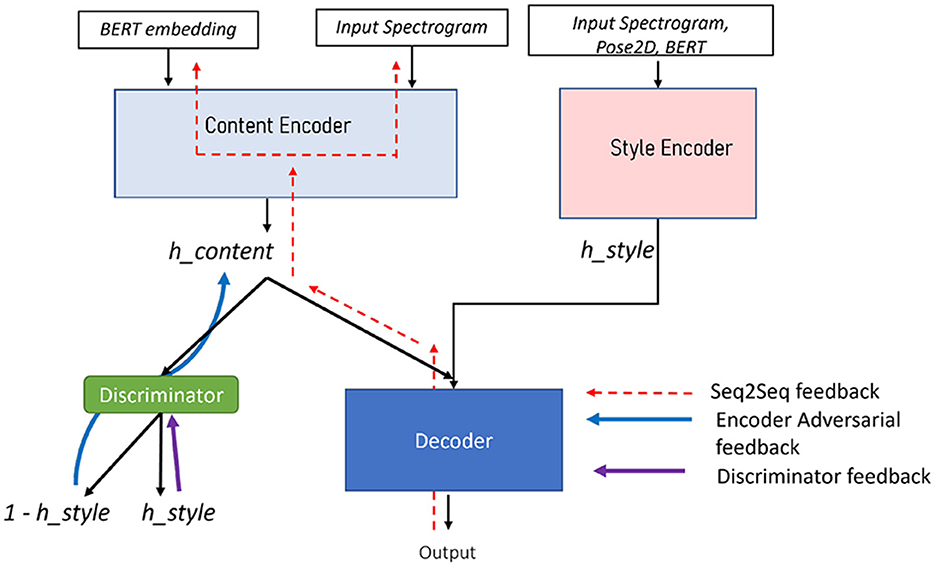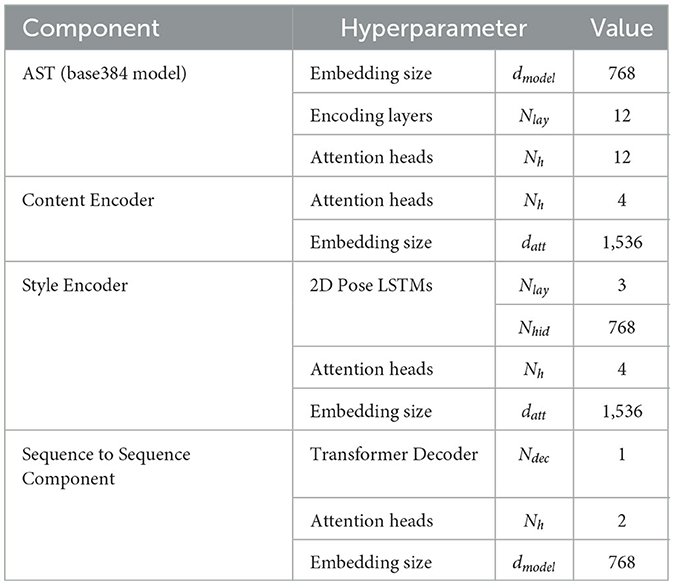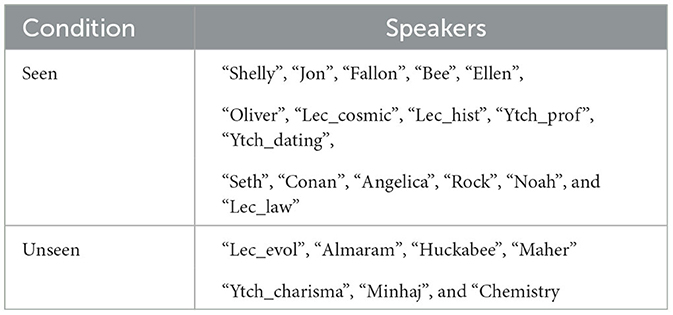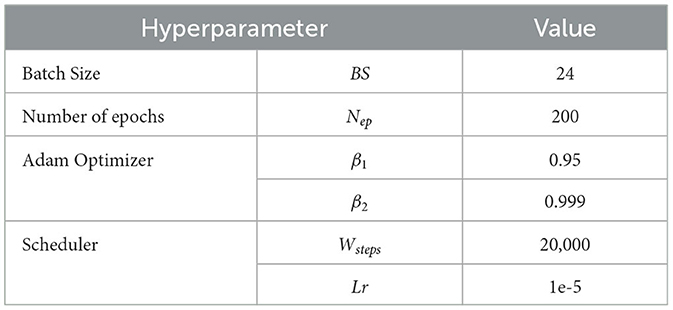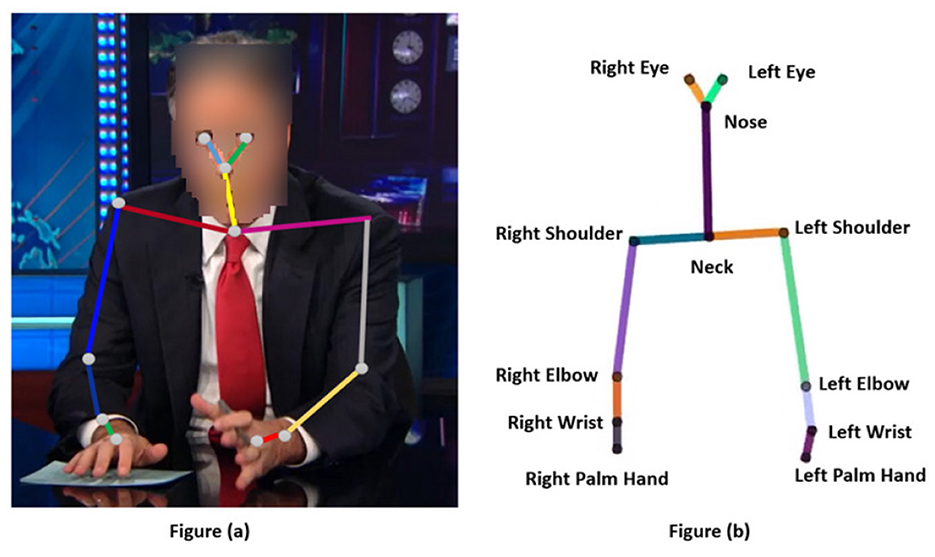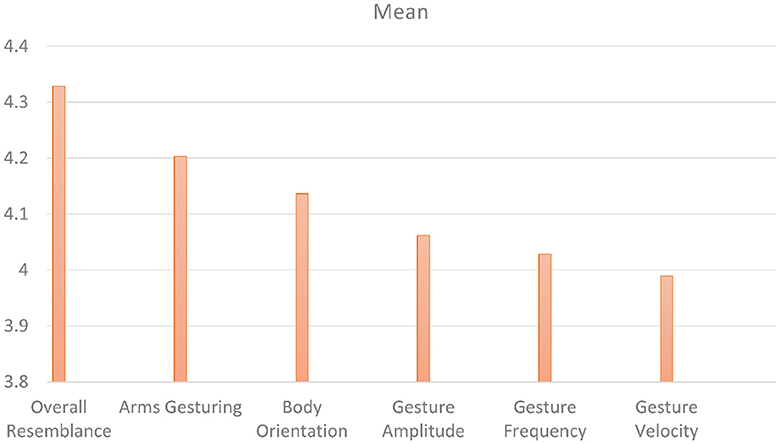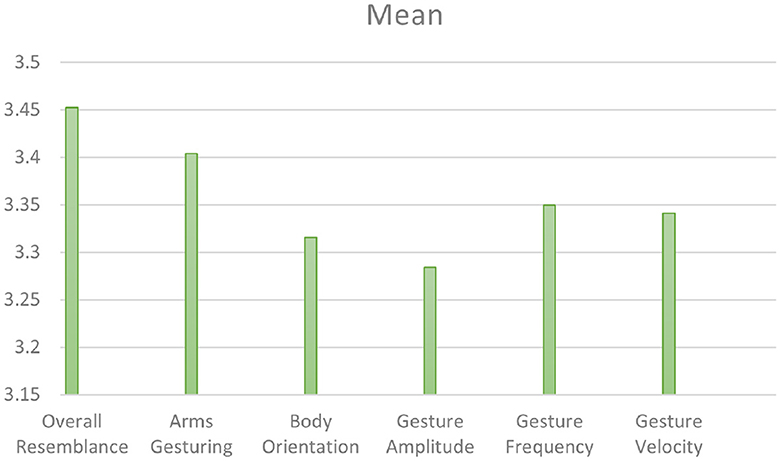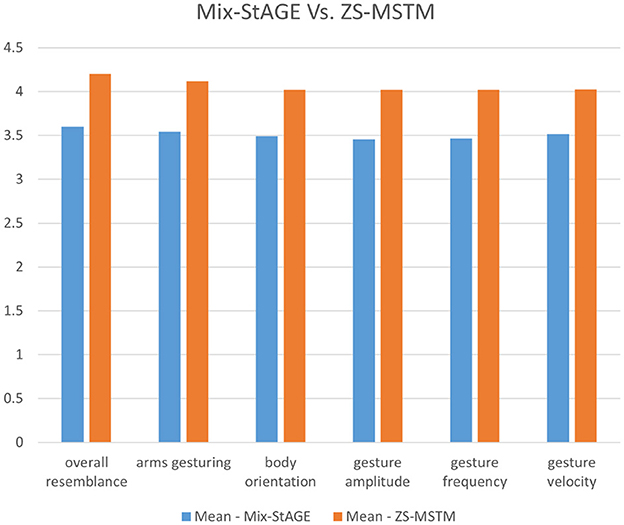- 1The Institute of Intelligent Systems and Robotics (ISIR), Sciences et Technologies de la Musique et du Son (STMS), Sorbonne University, Paris, France
- 2Centre National de la Recherche Scientifique (CNRS), The Institute of Intelligent Systems and Robotics (ISIR), Sorbonne University, Paris, France
- 3Sciences et Technologies de la Musique et du Son (STMS), Sorbonne University, Paris, France
Modeling virtual agents with behavior style is one factor for personalizing human-agent interaction. We propose an efficient yet effective machine learning approach to synthesize gestures driven by prosodic features and text in the style of different speakers including those unseen during training. Our model performs zero-shot multimodal style transfer driven by multimodal data from the PATS database containing videos of various speakers. We view style as being pervasive; while speaking, it colors the communicative behaviors expressivity while speech content is carried by multimodal signals and text. This disentanglement scheme of content and style allows us to directly infer the style embedding even of a speaker whose data are not part of the training phase, without requiring any further training or fine-tuning. The first goal of our model is to generate the gestures of a source speaker based on the content of two input modalities–Mel spectrogram and text semantics. The second goal is to condition the source speaker's predicted gestures on the multimodal behavior style embedding of a target speaker. The third goal is to allow zero-shot style transfer of speakers unseen during training without re-training the model. Our system consists of two main components: (1) a speaker style encoder network that learns to generate a fixed-dimensional speaker embedding style from a target speaker multimodal data (mel-spectrogram, pose, and text) and (2) a sequence-to-sequence synthesis network that synthesizes gestures based on the content of the input modalities—text and mel-spectrogram—of a source speaker and conditioned on the speaker style embedding. We evaluate that our model is able to synthesize gestures of a source speaker given the two input modalities and transfer the knowledge of target speaker style variability learned by the speaker style encoder to the gesture generation task in a zero-shot setup, indicating that the model has learned a high-quality speaker representation. We conduct objective and subjective evaluations to validate our approach and compare it with baselines.
1. Introduction
Embodied conversational agents are virtually embodied agents with a human-like appearance that are capable of autonomously communicating with people in a socially intelligent manner using multimodal behaviors (Lugrin, 2021). The field of research in ECAs has emerged as a new interface between humans and machines. ECAs behaviors are often modeled from human communicative behaviors. They are endowed with the capacity to recognize and generate verbal and non-verbal cues (Lugrin, 2021) and are envisioned to support humans in their daily lives. Our study revolves around modeling multimodal data and learning the complex correlations between the different modalities employed in human communication. More specifically, the objective is to model the multimodal ECAs' behavior with their behavior style.
Human behavior style is a socially meaningful clustering of features found within and across multiple modalities, specifically in linguistics (Campbell-Kibler et al., 2006), spoken behavior such as the speaking style conveyed by speech prosody (Obin, 2011; Moon et al., 2022), and nonverbal behavior such as hand gestures and body posture (Wagner et al., 2014; Obermeier et al., 2015).
Behavior style involves the ways in which people talk differently in different situations. The same person may have different speaking styles depending on the situation (e.g., at home, at the office or with friends). These situations can carry different social meanings (Bell, 1984). Different persons may also have different behavior styles while communicating in similar contexts. Behavior style is syntagmatic. It unfolds over time in the course of an interaction and during one's life course (Campbell-Kibler et al., 2006). It does not emerge unaltered from the speaker. It is continuously attuned, accomplished, and co-produced with the audience (Mendoza-Denton, 1999). It can be very self-conscious and at the same time can be extremely routinized to the extent that it resists attempts of being altered (Mendoza-Denton, 1999). Movements and gestures are person-specific and idiosyncratic in nature (McNeill et al., 2005), and each speaker has his or her own non-verbal behavior style that is linked to his/her personality, role, culture, etc.
A large number of generative models were proposed in the past few years for synthesizing gestures of ECAs. Style modeling and control in gesture is receiving attention in order to propose more expressive ECAs behaviors that could possibly be adapted to a specific audience (Neff et al., 2008; Karras et al., 2017; Cudeiro et al., 2019; Ginosar et al., 2019a; Ahuja et al., 2020; Alexanderson et al., 2020; Ahuja et al., 2022). They assume that behavior style is encoded in the body gesturing. Some of these works generate full-body gesture animation driven by text in the style of one specific speaker (Neff et al., 2008). Other approaches (Karras et al., 2017; Cudeiro et al., 2019; Ginosar et al., 2019a; Alexanderson et al., 2020) are speech-driven. For some of these approaches, the behavior style of the synthesized gestures is changed by exerting direct control over the synthesized gestures' velocity and force (Alexanderson et al., 2020). For others (Karras et al., 2017; Cudeiro et al., 2019; Ginosar et al., 2019a), they produced the gestures in the style of a single speaker by training their generative models on one single speaker's data and synthesized the gestures corresponding to this specific speaker's audio. Moreover, verbal and non-verbal behavior plays a crucial role in communication in human-human interaction (Norris, 2004). Generative models that aim to predict communicative gestures of ECAs must produce expressive semantically-aware gestures that are aligned with speech (Cassell, 2000).
We propose a novel approach to model behavior style in ECAs and to tackle the different behavior style modeling challenges. We view behavior style as being pervasive while speaking; it colors the communicative behaviors expressivity while speech content is carried by multimodal signals and text. To design our approach, we make the following assumptions for the separation of style and content information: style is possibly encoded across all modalities (text, speech, and pose) and varies little or not over time; content is encoded only by text and speech modalities and varies over time. Our approach aims at (1) synthesizing natural and expressive upper body gestures of a source speaker, by encoding the content of two input modalities—text semantics and Mel spectrogram, (2) conditioning the source speaker's predicted gesture on the multimodal style representation of a target speaker, and therefore rendering the model able to perform style transfer across speakers, and finally (3) allowing zero-shot style transfer of newly coming speakers that were not seen by the model during training. The disentanglement scheme of content and style allows us to directly infer the style embedding even of speakers whose data are not part of the training phase, without requiring any further training or fine-tuning.
Our model consists of two main components: first (1) a speaker style encoder network which goal is to model a specific target speaker style extracted from three input modalities—Mel spectrogram, upper-body gestures, and text semantics and second (2) a sequence-to-sequence synthesis network that generates a sequence of upper-body gestures based on the content of two input modalities—Mel spectrogram and text semantics—of a source speaker and conditioned on the target speaker style embedding. Our model is trained on the multi-speaker database PATS, which was proposed in Ahuja et al. (2020) and designed to study gesture generation and style transfer. It includes three main modalities that we are considering in our approach: text semantics represented by BERT embeddings, Mel spectrogram, and 2D upper body poses.
Our contributions can be listed as follows:
1. We propose the first approach for zero-shot multimodal style transfer approach for 2D pose synthesis. At inference, an embedding style vector can be directly inferred from multimodal data (text, speech, and poses) of any speaker by simple projection into the embedding style space [similar to the one used in Jia et al. (2018)]. The style transfer performed by our model allows the transfer of style from any unseen speakers, without further training or fine-tuning of our trained model. Thus, it is not limited to the styles of the speakers of a given database.
2. Unlike the work of Ahuja et al. (2020) and previous works, the encoding of the style takes into account three modalities: body poses, text semantics, and speech—Mel spectrograms, which are important for gesture generation (Ginosar et al., 2019a; Kucherenko et al., 2019) and linked to style. We encode and disentangle content and style information from multiple modalities. On the one hand, a content encoder is used to encode a content matrix from text and speech signal; on the other hand, a style encoder is used to encode a style vector from all text, speech, and pose modalities. A fader loss is introduced to effectively disentangle content and style encodings (Lample et al., 2017).
In the following sections, we first discuss the related works and more specifically the existing behavior style modeling approaches as well as their limitations. Next, in Section 3, we dive into the details of our model's architecture, describe its training regime and the objective and subjective evaluations we conducted. We then discuss in Section 4 the objective and subjective evaluation results. Next, in Section 5, we review the key findings of our study, compare it to prior research, and discuss its main limitations. We conclude by discussing future directions for our study.
2. Related Work
Since few years, a large number of gesture generative models have been proposed, principally based on sequential generative parametric models such as hidden Markov models (HMM) and gradually moving toward deep neural networks enabling spectacular advances over the last few years. Hidden Markov models were previously used to predict head motion driven by prosody (Sargin et al., 2008) and body motion (Levine et al., 2009; Marsella et al., 2013).
Chiu and Marsella (2014) proposed an approach for predicting gesture labels from speech using conditional random fields (CRFs) and generating gesture motion based on these labels, using Gaussian process latent variable models (GPLVMs). These studies focus on the gesture generation task driven by either one modality, namely, speech or by the two modalities—speech and text. Their study focuses on producing naturalistic and coherent gestures that are aligned with speech and text, enabling a smoother interaction with ECAs and leveraging the vocal and visual prosody. The non-verbal behavior is therefore generated in conjunction with the verbal behavior. LSTM networks driven by speech were recently used to predict sequences of gestures (Hasegawa et al., 2018) and body motions (Shlizerman et al., 2018; Ahuja et al., 2019). LSTMs were additionally employed for synthesizing sequences of facial gestures driven by text and speech, namely, the fundamental frequency (F0) (Fares, 2020; Fares et al., 2021a). Generative adversarial networks (GANs) were proposed to generate realistic head motion (Sadoughi and Busso, 2018) and body motions (Ferstl et al., 2019). Furthermore, transformer networks and attention mechanisms were recently used for upper-facial gesture synthesis based on multimodal data—text and speech (Fares et al., 2021b). Facial (Fares, 2020; Fares et al., 2021b) and hand (Kucherenko et al., 2020) gestures driven by both acoustic and semantic information are the closest approaches to our gesture generation task; however, they cannot be used for the style transfer task.
Beyond the realistic generation of human non-verbal behavior, style modeling and control in gesture is receiving more attention in order to propose more expressive behaviors that could possibly adapted to a specific audience (Neff et al., 2008; Karras et al., 2017; Cudeiro et al., 2019; Ginosar et al., 2019a; Ahuja et al., 2020; Alexanderson et al., 2020; Ahuja et al., 2022). Neff et al. (2008) proposed a system that produces full-body gesture animation driven by text, in the style of a specific performer. Alexanderson et al. (2020) proposed a generative model for synthesizing speech-driven gesticulation, and they exerted directorial control over the output style such as gesture level and speed. Karras et al. (2017) proposed a model for driving 3D facial animation from audio. Their main objective is to model the style of a single actor by using a deep neural network that outputs 3D vertex positions of meshes that correspond to a specific audio. Cudeiro et al. (2019) also proposed a model that synthesizes 3D facial animation driven by speech signal. The learned model, VOCA (Voice Operated Character Animation), takes any speech signal as input–even speech in languages other than English and realistically animates a wide range of adult faces. Conditioning on subject labels during training allows the model to learn a variety of realistic speaking styles. VOCA also provides animator controls to alter speaking style, identity-dependent facial shape, and pose (i.e., head, jaw, and eyeball rotations) during animation.
Ginosar et al. (2019a) proposed an approach for generating gestures given audio speech; however, their approach uses models trained on single speakers. The aforementioned studies have focused on generating non-verbal behaviors (facial expression, head movement, and gestures in particular) aligned with speech (Neff et al., 2008; Karras et al., 2017; Cudeiro et al., 2019; Ahuja et al., 2020). They have not considered multimodal data when modeling style as well as when synthesizing gestures.
To the best of our knowledge, the only attempts to model and transfer the style from multi-speakers database have been proposed by Ahuja et al. (2020, 2022). Ahuja et al. (2020) presented Mix-StAGE, a speech-driven approach, that trains a model from multiple speakers while learning a unique style embedding for each speaker. They created PATS, a dataset designed to study various styles of gestures for a large number of speakers in diverse settings. In their proposed neural architecture, a content and a style encoder are used to extract content and style information from speech and pose. To disentangle style from content information, they assumed that style is only encoded through the pose modality, and the content is shared across speech and pose modalities. A style embedding matrix whose each vector represents the style associated to a specific speaker from the training set. During training, they further proposed a multimodal GAN strategy to generate poses either from the speech or pose modality. During inference, the pose is inferred by only using the speech modality and the desired style token.
However, their generative model is conditioned on gesture style and driven by audio. It does not include verbal information. It cannot perform zero-shot style transfer on speakers that were not seen by their model during training. In addition, the style is associated with each unique speaker, which makes the distinction unclear between each speaker's specific style—idiosyncrasy, the style that is shared among a set of speakers of similar settings (i.e., TV show hosts, journalists, etc...), and the style that is unique to each speaker's prototype gestures that are produced consciously and unconsciously. Moreover, the style transfer is limited to the styles of PATS speakers, which prevents the transfer of style from an unseen speaker. Furthermore, the proposed architecture is based on the disentangling of content and PATS style information, which is based on the assumption that style is only encoded by gestures. However, both text and speech also convey style information, and the encoding of style must take into account all the modalities of human behavior. To tackle those issues, Ahuja et al. (2022) presented a few-shot style transfer strategy based on neural domain adaptation accounting for a cross-modal grounding shift between the source speaker and target style. This adaptation still requires 2 min of the style to be transferred. To the best of our knowledge, our approach is the first to synthesize gestures from a source speaker, which are semantically-aware, speech driven, and conditioned on a multimodal representation of the style of target speakers in a zero-shot configuration i.e., without requiring any further training or fine-tuning.
3. Materials and methods
3.1. Model architecture
We propose ZS-MSTM (Zero-Shot Multimodal Style Transfer Model), a transformer-based architecture for stylized upper-body gesture synthesis, driven by the content of a source speaker's speech—text semantics represented by BERT embeddings and audio Mel spectrogram—and conditioned on a target speaker's multimodal style embedding. The stylized generated gestures correspond to the style of target speakers that have been seen and unseen during training.
As depicted in Figure 1, the system is composed of three main components:
1. A speaker style encoder network that learns to generate a fixed-dimensional speaker embedding style from a target speaker multimodal data: 2D poses, BERT embeddings, and Mel spectrogram, all extracted from videos in a database.
2. A sequence-to-sequence gesture synthesis network that synthesizes upper-body behavior (including hand gestures and body poses) based on the content of two input modalities—text embeddings and Mel spectrogram—of a source speaker and conditioned on the target speaker style embedding. A content encoder is presented to encode the content of the Mel spectrogram along with BERT embeddings.
3. An adversarial component in the form of a fader network (Lample et al., 2017) is used for disentangling style and content from the multimodal data.
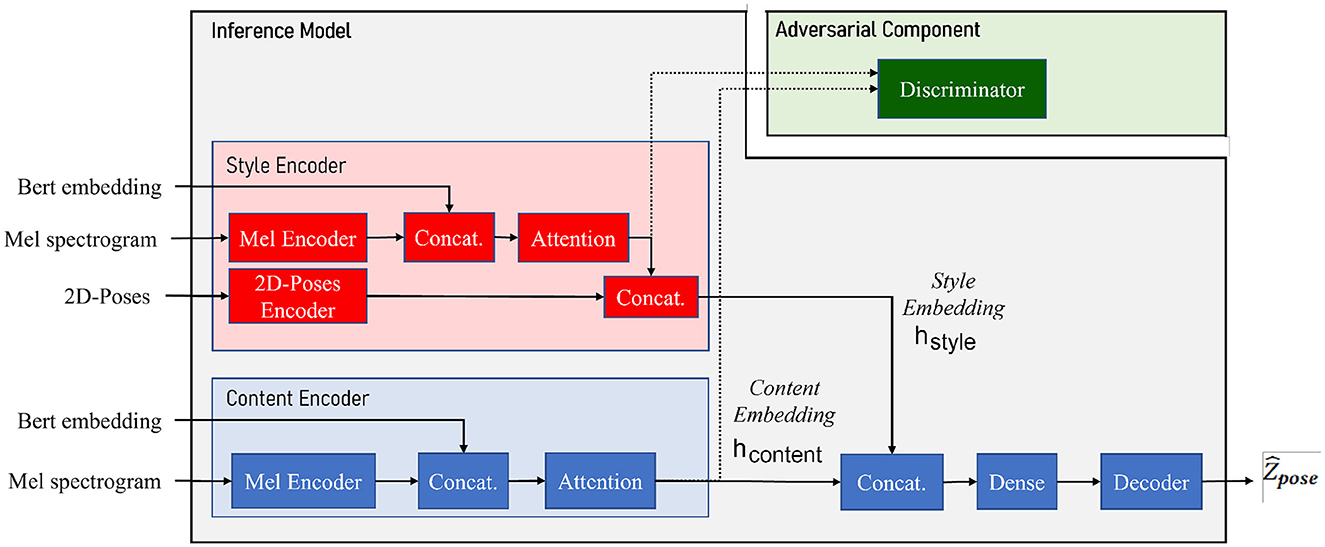
Figure 1. ZS-MSTM (Zero-Shot Multimodal Style Transfer Model) architecture. Content encoder (further referred to as Econtent) is used to encode content embedding hcontent from BERT text embeddings Xtext and speech Mel-spectrograms Xspeech using a speech encoder . Style encoder (further referred to as Estyle) is used to encode style embedding hstyle from multimodal text Xtext, speech Xspeech, and pose Xpose using speech encoder and pose encoder . The generator G is a transformer network that generates the sequence of poses from the sequence of content embedding hcontent and the style embedding vector hstyle. The adversarial module relying on the discriminator Dis is used to disentangle content and style embeddings hcontent and hstyle.
At inference time, the adversarial component is discarded, and the model can generate different versions of poses when fed with different style embeddings. Gesture styles for the same input speech can be directly controlled by switching the value of the style embedding vector hstyle or by calculating this embedding from a target speaker's multimodal data fed as input to the Style Encoder.
ZS-MSTM illustrated in Figure 1 aims at mapping multimodal speech and text feature sequences into continuous upper-body gestures, conditioned on a speaker style embedding. The network operates on a segment-level of 64 timesteps: the inputs and output of the network consist of one feature vector for each segment S of the input text sequence. The length of the segment-level input features (text and audio) corresponds to t = 64 timesteps (as provided by PATS Corpus). The model generates a sequence of gestures corresponding to the same segment-level features given as inputs. Gestures are sequences of 2D poses represented by x and y positions of the joints of the skeleton. The network has an embedding dimension dmodel equal to 768.
3.1.1. Content encoder
The content encoder Econtent illustrated in Figure 1 takes as inputs BERT embedding Xtext and audio Mel spectrograms Xspeech corresponding to each S. Xtext is represented by a vector of length 768 - BERT embedding size used in PATS Corpus. Xspeech is encoded using Mel Spectrogram Transformer (AST) pre-trained base384 model (Gong et al., 2021).
AST operates as follows: the input Mel spectrogram which has 128 frequency bins is split into a sequence of 16 × 16 patches with overlap and then is linearly projected into a sequence of 1D patch vectors, which is added with a positional embedding. We append a [CLS] token to the resulting sequence, which is then input to a Transformer Encoder. AST was originally proposed for audio classification. Since we do not intend to use it for a classification task, we remove the linear layer with sigmoid activation function at the output of the transformer encoder. We use the transformer encoder's output of the [CLS] token as the Mel spectrogram representation. The transformer encoder has an embedding dimension equals to dmodel, Nenc equal to 12 encoding layers, and Nh equals to 12 attention heads.
The segment-level encoded Mel spectrogram is then concatenated with the segment-level BERT embedding. A self-attention mechanism is then applied on the resulting vector. The multi-head attention layer has Nh equal to four attention heads, and an embedding size datt is equal to datt = dmodel+768. The output of the attention layer is the vector hcontent, a content representation of the source speaker's segment-level Mel spectrogram and text embedding, and it can be written as follows:
where sa(.) denotes self-attention.
3.1.2. Style encoder
As discussed previously, behavior style is a clustering of features found within and across modalities, encompassing verbal, and non-verbal behavior. It is not limited to gestural information. We consider that behavior style is encoded in a speaker's multimodal - text, speech, and pose–behavior. As illustrated in Figure 1, the style encoder Estyle takes as input, at the segment-level, Mel spectrogram Xspeech, BERT embedding Xtext, and a sequence of (X, Y) joints positions that correspond to a target speaker's 2D poses Xpose. AST is used to encode the audio input spectrogram. Nlay equal to three layers of LSTMs with a hidden-size equal to dmodel are used to encode the vector representing the 2D poses. The last hidden layer is then concatenated with the audio representation. Next, a multi-head attention mechanism is applied on the resulting vector. This attention layer has Nh equal to four attention heads and an embedding size equal to datt. Finally, the output vector is concatenated with the 2D poses vector representation. The resulting vector hstyle is the output speaker style embedding that serves to condition the network with the speaker style. The final style embedding hstyle can therefore be written as follows:
where sa(.) denotes self-attention.
3.1.3. Sequence to sequence gesture synthesis
The stylized 2D poses are generated given the sequence of content representation hcontent of the source speaker's Mel spectrogram and text embeddings obtained at the S-level and conditioned by the style vector embedding hstyle generated from a target speaker's multimodal data. For decoding the stylized 2D-poses, the sequence of hcontent and the vector hstyle are concatenated (by repeating the hstyle vector for each segment of the sequence) and passed through a Dense layer of size dmodel. We then give the resulting vector as input to a transformer decoder. The transformer decoder is composed of Ndec = 1 decoding layer, with Nh = 2 attention heads, and an embedding size equal to dmodel. Similar to the one proposed in Vaswani et al. (2017), it is composed of residual connections applied around each of the sub-layers, followed by layer normalization. Moreover, the self-attention sub-layer in the decoder stack is altered to prevent positions from attending to subsequent positions. The output predictions are offset by one position. This masking makes sure that the predictions for position index j depends only on the known outputs at positions that are less than j. For the last step, we perform a permutation of the first and the second dimensions of the vector generated by the transformer decoder. The resulting vector is a sequence of 2D-poses which corresponds to
where G is the transformer generator conditioned on latent content embedding hcontent and style embedding hstyle. The generator loss of the transformer gesture synthesis can be written as
3.1.4. Adversarial component
Our approach of disentangling style from content relies on the fader network disentangling approach (Lample et al., 2017), where a fader loss is introduced to effectively separate content and style encodings, as depicted in Figure 2. The fundamental feature of our disentangling scheme is to constrain the latent space of hcontent to be independent of the style embeddings hstyle. Concretely, it means that the distribution over hcontent of the latent representations should not contain the style information. A fader network is composed of an encoder which encodes the input information X into the latent code hcontent, a decoder which decodes the original data from the latent, and an additional variable hstyle used to condition the decoder with the desired information (a face attribute in the original paper). The objective of the fader network is to learn a latent encoding hcontent of the input data that is independent on the conditioning variable hstyle while both variables are complementary to reconstruct the original input data from the latent variable hcontent and the conditioning variable hstyle. To do so, a discriminator Dis is optimized to predict the variable hstyle from the latent code hcontent; on the contrary, the auto-encoder is optimized using an additional adversarial loss so that the classifier Dis is unable to predict the variable hstyle. Contrary to the original fader network in which the conditional variable is discrete within a finite binary set (0 or 1 for the presence or absence attribute), in this study, the conditional variable hstyle is continuous. We then formulate this discriminator as a regression on the conditional variable hstyle: the discriminator learns to predict the style embedding hstyle from the content embedding hcontent as
While optimizing the discriminator, the discriminator loss must be as low as possible, such as
In turn, optimizing the generator loss including the fader loss , the discriminator must not be able to predict correctly the style embedding hstyle from the content embedding hcontent conducting to a high discriminator error and thus a low fader loss. The adversarial loss can be written as
To be consistent, the style prediction error is preliminary normalized within 0 and 1 range.
Finally, the total generator loss can therefore be written as follows:
where λ is the adversarial weight that starts off at 0 and is linearly incremented by 0.01 after each training step.
The discriminator Dis and the generator G are then optimized alternatively as described in Lample et al. (2017).
All ZS-MSTM hyperparameters were chosen empirically and are summarized in Table 1.
3.2. Training regime
This section describes the training regime we follow for training ZS-MSTM. We trained our network using the PATS Corpus (Ahuja et al., 2020). PATS was created to study various styles of gestures. The dataset contains upper-body 2D pose sequences aligned with corresponding Mel spectrogram and BERT embeddings. It offers 251 hours of data, with a mean of 10.7 s and a standard deviation of 13.5 s per interval. PATS gathers data from 25 speakers with different behavior styles from various settings (e.g., lecturers and TV shows hosts). It contains also several annotations. The spoken text has been transcribed in PATS and aligned with the speech. The 2D body poses have been extracted with OpenPose.
Each speaker is represented by their lexical diversity and the spatial extend of their arms. While in PATS, arms and fingers have been extracted, we do not consider finger data in our study; that is we do not model and predict 2D finger joints. This choice arises as the analysis of finger data is very noisy and not very accurate. We model 11 joints that represent upper body and arm joints.
We consider two test conditions: seen speaker and unseen speaker. The seen speaker condition aims to assess the style transfer correctness that our model can achieve when presented with speakers that were seen during training as target style. On the other hand, the unseen speaker condition aims to assess the performance of our model when presented with unseen target speakers to perform zero-shot style transfer. Seen and unseen speakers are specifically selected from PATS to cover a diversity of stylistic behavior with respect to lexical diversity and spatial extent as reported by Ahuja et al. (2020).
For each PATS speaker, there is a train, validation, and test set already defined in the database. For testing the seen speaker condition, our test set includes the train sets of 16 PATS speakers. Six other speakers are selected for the unseen speaker condition, and their test sets are also used for our experiments. These six speakers differ in their behavior style and lexical diversity. Seen and unseen speakers are listed in Table 2.
We developed our model using Pytorch and trained it on an NVIDIA Corporation GP102 (GeForce GTX 1080 Ti) machine. Each training batch contains BS = 24 pairs of word embeddings, Mel spectrogram, and their corresponding sequence of (X, Y) joints of the skeleton (of the upper-body pose). We use Adam optimizer with β1 = 0.95, β2 = 0.999. For balanced learning, we use a scheduler with an initial learning rate Lr equal to 1e-5, with Wsteps equal to 20,000. We train the network for Nep = 200. All features values are normalized so that the dataset mean and standard deviation are 0 and 0.5, respectively. Table 3 summarizes all hyperparameters used for training.
3.3. Objective evaluation
To validate our approach and assess the stylized generated gestures, we conducted an objective evaluation for the two conditions seen speakers and unseen speakers.
3.3.1. Objective metrics
In our study, we have defined behavior style by the behavior expressivity of a speaker. To evaluate objectively our studies, we define metrics to compare the behavior expressivity generated by our model, with the target speaker's behavior expressivity and source speaker's behavior expressivity.
Following studies on behavior expressivity by Wallbott (1998) and Pelachaud (2009), we define four objective behavior dynamics metrics to evaluate the style transfer of different target speakers: acceleration, jerk, and velocity that are averaged over the values of all upper-body joints, as well as the speaker's average bounding box perimeter (BB perimeter) of his/her body movements extension.
In addition, we compute the acceleration, jerk, and velocity of only the left and right wrists to obtain information on the arms movements expressivity (Wallbott, 1998; Kucherenko et al., 2019).
For both conditions SD and SI, we define two sets of distances:
1. Dist.(Source, Target): representing the average distance between the source style and the target style.
2. Dist.(ZS-MSTM, Target): representing the average distance between our model's gestures style and the target style.
More specifically, after computing the behavior expressivity and BB perimeter of our model's generated gestures, the ones of source speakers and the ones of the target speakers, we calculate the average distance as follows:
where x denotes Source for computing Distavg(Source, Target) and ZS-MSTM for computing Distavg(ZS-MSTM, Target).
To investigate the impact of each input modality on our style encoder, we conducted ablation studies on different versions of our model. Specifically, we performed ablations of the pose modality, text modality, and audio modality. We also compared the performance of the full model with that of the baseline DiffGAN Ahuja et al. (2022). We employed two metrics to evaluate the correlation and timing between gestures and spoken language: Probability of Correct Keypoints (PCK) and L1 distance. For PCK, we averaged the values over α = 0.1 and 0.2, as suggested in Ginosar et al. (2019b). L1 distance was calculated between the generated gestures and the corresponding target ground truth gestures.
3.4. Human perceptual studies
We conduct three human perceptual studies.
1. Study 1—To investigate human perception of the stylized upper-body gestures produced by our model, we conduct a human perceptual study that aims to assess the style transfer of speakers seen during training—seen speaker condition.
2. Study 2—We conduct another human perceptual study that aims to assess the style transfer of speakers unseen during training—unseen speaker condition.
3. Study 3—We additionally conduct a third human perceptual study to compare ZS-MSTM's produced stylized gestures in seen speaker and unseen speaker conditions to Mix-StAGE which we consider our baseline.
The evaluation studies are conducted with 35 participants that were recruited through the online crowd-sourcing website Prolific. Participants are selected such that they are fluent in English. Attention checks are added in the beginning and the middle of each study to filter out inattentive participants. All the animations presented in these studies are in the form of 2D sticks.
Study 1 and 2. For Study 1 and 2, we presented 60 stimuli of 2D stick animations. Each study included 30 stimuli. A stimulus is a triplet of 2D animations composed of those as follows:
• a 2D animation with the source style
• a 2D animation with the target style
• a 2D animation of ZS-MSTM's prediction after performing the style transfer.
Figure 3 illustrates the three animations we present for each set of questions. The animation of the target style is the Reference. The animation of our model's predictions, and the source style is either Animation A or Animation B (randomly chosen).
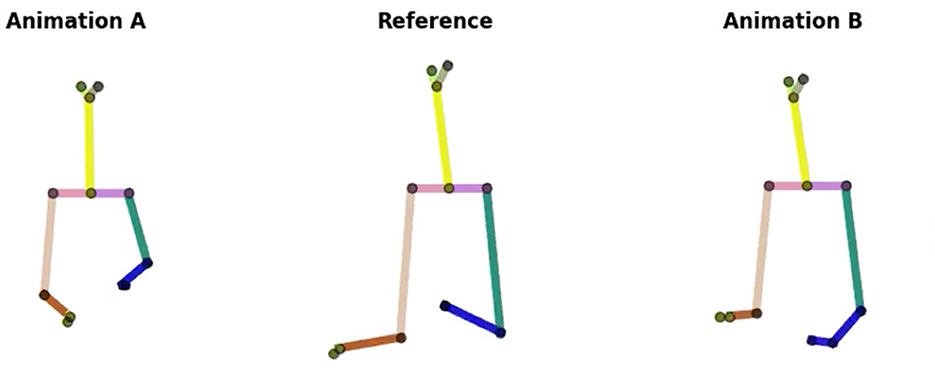
Figure 3. Three 2D stick animations: Animation A, Reference, and Animation B. The target style is represented by Reference. ZS-MSTM's predictions and the source style are illustrated in Animation A or B.
For each triplet of animations, we asked six questions to evaluate six factors related to the resemblance of the produced gestures w.r.t the the source style and target style:
1. Please rate the overall resemblance of the Reference w.r.t A and B (Factor 1 - Overall resemblance).
2. Please rate the resemblance of the Left (L) and Right (R) arms gesturing of the Reference w.r.t the left and right arm gesturing of A and B (Factor 2 - Arms gesturing).
3. Please rate the resemblance of the body orientation of the Reference w.r.t the body orientation of A and B (Factor 3 - Body orientation).
4. Please rate the resemblance of the gesture amplitude of the Reference w.r.t the gesture amplitude of A and B (Factor 4 - Gesture amplitude).
5. Please rate the resemblance of the gesture frequency of the Reference w.r.t the gesture frequency of A and B (Factor 5 - Gesture frequency).
6. Please rate the resemblance of the gesture velocity of Reference w.r.t the gesture velocity of A and B (Factor 6 - Gesture velocity).
Each factor is rated on a 5 likert scale, as follows:
1. Reference is very similar to A.
2. Reference is mostly similar to A.
3. Reference is in between A and B.
4. Reference is mostly similar to B.
5. Reference is very similar to B.
Training. Each study includes a training at its beginning. The training provides an overview of the 2D upper-body skeleton of the virtual agent, its composition, and gesturing. The goal of the training is to get the participants familiarized with the 2D skeleton before starting the study. More specifically, the training included a description of how the motion of a speaker in a video is extracted by detecting his/her facial and body motion and extracting his/her 2D skeleton of joints and stated that in a similar fashion, the eyes and upper-body movement of a virtual agent are represented by a 2D skeleton of joints, as depicted in Figure 4.
Moreover, we present and describe different shots of the 2D skeleton gesturing with its right/left arms, and with different body orientation, which is described as the orientation of the shoulders and neck.
Pre-tests. We conducted pre-tests to make sure that the 2D animations are comprehensible by participants as well as the questions. Participants reported that the training, stimuli, and questions are coherent and comprehensible; however, each study was too long, as it lasted for 30 min. For this reason, we divided each study to three, such that each study includes only 10 stimuli, and is conducted by different participants. Hence, six studies including a pre-training and the evaluation of 10 stimuli were conducted by 35 participants that are different.
Study 3. For Study 3, we present 20 stimuli consisting of triplets of 2D stick animations. Similar to Study 1 and Study 2, for each triplet, we present: Animation A, Reference, and Animation B. The animation of the target style is the Reference. The animation of Mix-StAGE's predictions, and the source style is either Animation A or Animation B (randomly chosen). We note that these stimuli include the same source and target styles that were used in Study 1 and Study 2 and which were randomly chosen. Study 3 also included training at its beginning, which is the same as the one previously described.
4. Results
4.1. Objective evaluation results
Objective evaluation experiments are conducted for evaluating the performance of our model in the seen speaker and unseen speaker conditions. For seen speaker condition, experiments are conducted on the test set that includes the 16 speakers that are seen by our model during training. For unseen speaker condition, experiments are also conducted on another test set that includes the six speakers that were not seen during training.
Figure 5 reports the experimental results on the seen speaker test set. It illustrates the results of Dist.(Source, Target) in terms of behaviors dynamics and speaker bounding box perimeter between the target speaker style and the source speaker style.
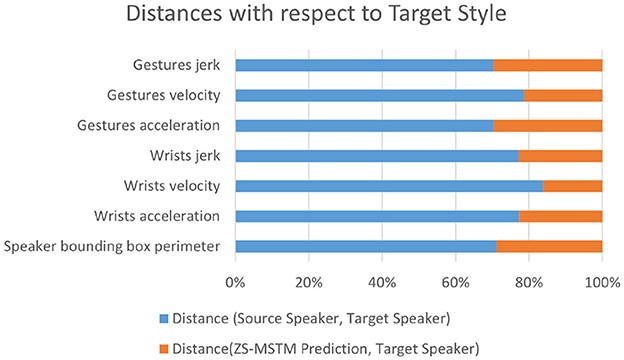
Figure 5. Distances between the target speaker style and each of the source style and our model's generated gestures style for seen target speakers.
For seen speaker condition (Figure 5), Dist.(Source, Target) is higher than 70% of the total distance for all behavior dynamics metrics.; thus, Dist.(ZS-MSTM, Target) is less than 30% of the total distance for all behavior dynamics metrics. Wrists velocity, jerk, and acceleration results reveal that the virtual agent's arm movements show the same expressivity dynamics as the target style [Dist.(ZS-MSTM, Target) < 22%].
The style transfer from target speaker “Shelly” to source speaker “Angelica”—knowing that Angelica is a Seen Speaker—shows that the distance of predicted gestures' behavior dynamics metrics are close (distance < 20%) to “Shelly” (target style), while the ones between “Angelica” and “Shelly” are far (distance > 80%).
The perimeter of the prediction's bounding box (BB) is closer (distance < 30%) to the target speaker's BB perimeter than the source. The closeness between predictions dynamics behavior metrics values are shown for all speakers in the seen speaker condition, specifically for the following style transfers—target to source: “Fallon” to “Shelly,” “Bee” to “Shelly,” “Conan” to “Angelica,” and “Oliver” to “lec_cosmic” which are considered having different lexical diversities, as well as spatial average extent, as reported by the authors of PATS (Ahuja et al., 2020).
Experimental results for the unseen speaker test set are depicted in Figure 6. Results reveal that our model is capable of reproducing the style of the six unseen speakers. As depicted in Figure 6, for all behavior dynamics metrics, as well as the bounding box perimeter, Dist.(Source, Target) is higher than 50% of the total distances for all metrics. Results show that for wrists velocity, jerk, and acceleration, Dist.(ZS-MSTM, Target) is less than 33%. Thus, arm movement's expressivity produced by ZS-MSTM is close to the one of the target speaker style. Moreover, the perimeter of the prediction's bounding box is close (distance < 30%) to the target speaker's, while the distance between the BB perimeter of the source and the target is far (distance > 70%). While our model has not seen “Lec_evol”'s multimodal data during training, it is yet capable of transferring his behavior expressivity style to the source speaker “Oliver.” It is also capable of performing zero-shot style transfer from the target speaker “Minhaj” to the source speaker “Conan.” In fact, results show that wrists acceleration and jerk values of our model's generated gestures are very close to those of the target speaker “Minhaj.” We observe the same results for the six speakers for the unseen speaker condition.
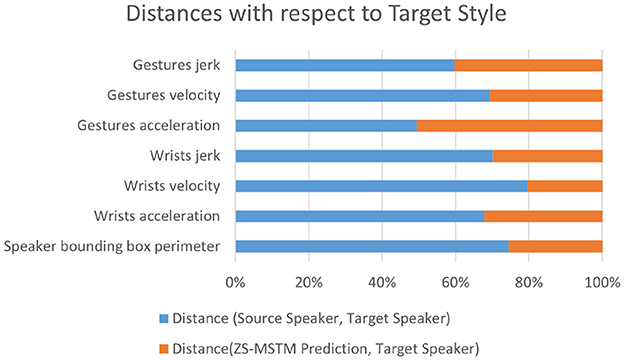
Figure 6. Distances between the target speaker style and each of the source style and our model's generated gestures style for unseen target speakers.
We additionally conducted Fisher's LSD test to do pair-wise comparisons on all metrics, for the two set of distances—Dist.(Source, Target), and Dist.(ZS-MSTM, Target)—in both conditions. We find significant results (p < 0.003) for all distances in both conditions.
The results of our ablation studies are summarized in Table 4. Specifically, we trained three versions of our ZS-MSTM model, each with one modality (either text, audio, or pose) removed from the style encoder. We evaluated the performance of each model using the L1 distance and PCK metrics, comparing the predictions to the target ground truth in all conditions. Our results (see Table 4) show that the L1 distance between the predictions of the ablated models and the ground truth is higher compared to the full model condition, for both seen (Oliver) and unseen (Chemistry, Maher) target styles. This trend was observed across all three ablation conditions. In addition, we compared our results to the baseline DiffGAN (Ahuja et al., 2022) and found that our ZS-MSTM model consistently outperforms DiffGAN in terms of L1 distance, with higher confidence intervals reported as standard deviation on all source-target pairs. Furthermore, we evaluated the PCK metric for all source-target pairs and found that our ZS-MSTM model achieves higher accuracy than the ablated models for all style transfers, with higher confidence intervals. This indicates that our model produces joint positions that are accurate and closely match the ground truth. When comparing ZS-MSTM with DiffGAN, our model outperforms DiffGAN in terms of PCK, with higher confidence intervals.
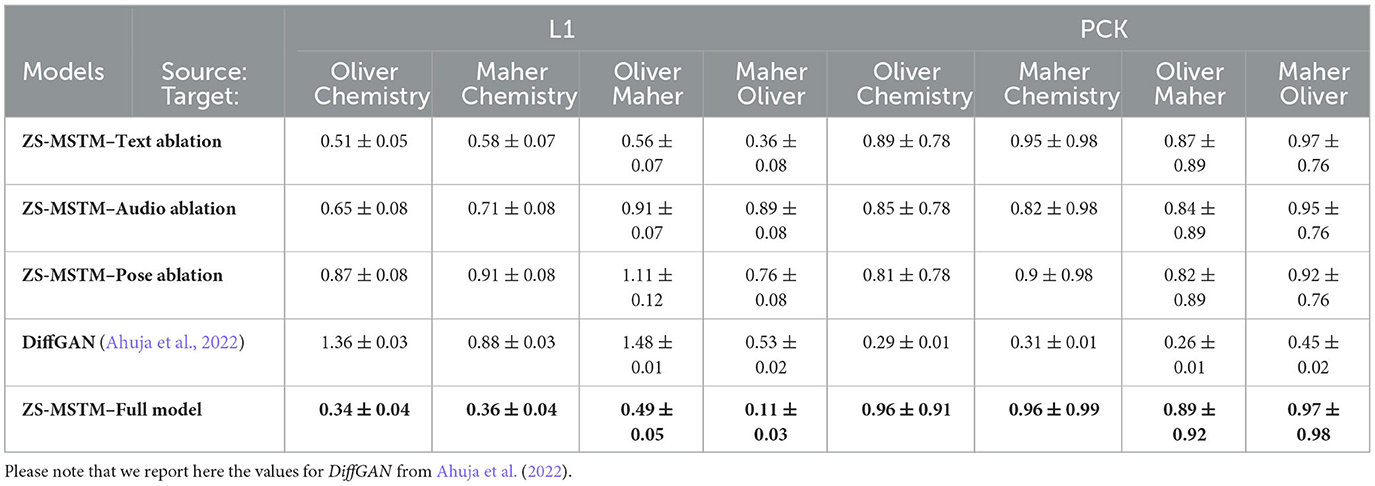
Table 4. Comparison of our ZS-MSTM model with DiffGAN (Ahuja et al., 2022) used as a baseline, as well as with different versions of our model where we removed the text, audio, and pose modalities from the style encoder.
4.1.1. Additional t-SNE analysis
In this study, the style encoder is agnostic: it is the attention weights that make it possible to exploit the different modalities given as input to the style encoder.
We conducted a t-SNE post-hoc analysis of the distributions of the style vectors at the output of each modality. Figure 7 illustrates the 2D t-SNE plots of Mel Embeddings, Pose Embeddings, Text Embeddings, and the final Style Embeddings produced by our model ZS-MSTM. We found that the motion style depends most on the pose modality, followed by the speech, then the text semantics.
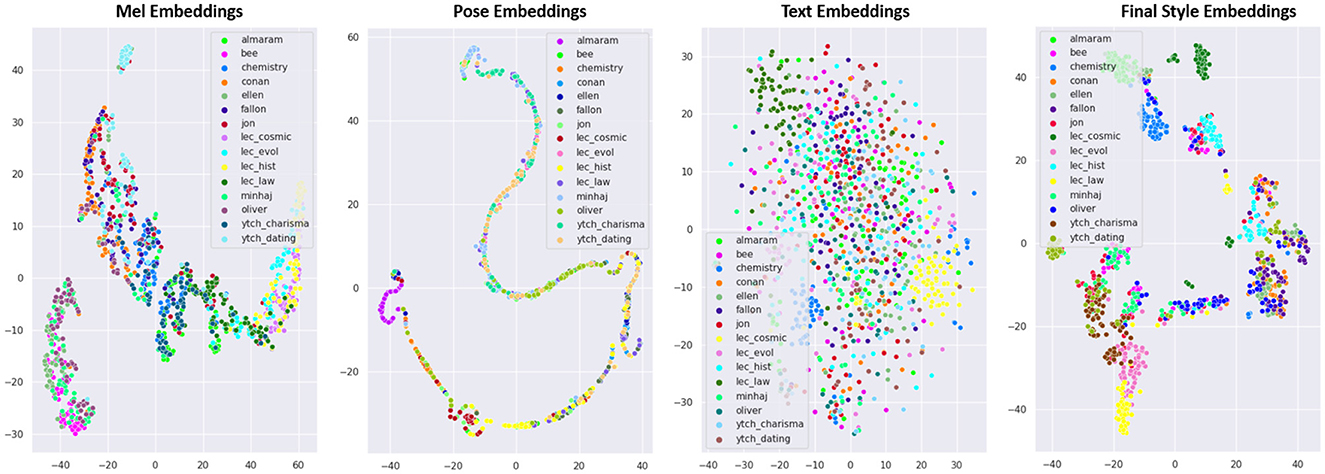
Figure 7. 2D TSNE analysis of the generated Mel Embeddings, Pose Embeddings, Text Embeddings, and the final Style Embeddings.
4.2. Human perceptual studies results
Study 1—Seen Speakers.
Our first perceptive study (Study 1) aims to evaluate the style transfer of speakers seen during training. Figure 8 shows the mean scores obtained on the six factors for the condition "seen speakers". On a 5-point Likert scale, the overall resemblance factor obtained a score of 4.32, which means that the ZS-MSTM's 2D animations closely resemble the 2D animations of the seen target style. The resemblance is also reflected by the mean scores of arms gesturing, which is between 3.28 andbody orientation, gesture amplitude, gesture frequency, as well as gesture velocity, which is between 3.99 and 4.2. We observed that for all factors, most of the participants gave a score between 3.8 and 5, as depicted in Figure 9.
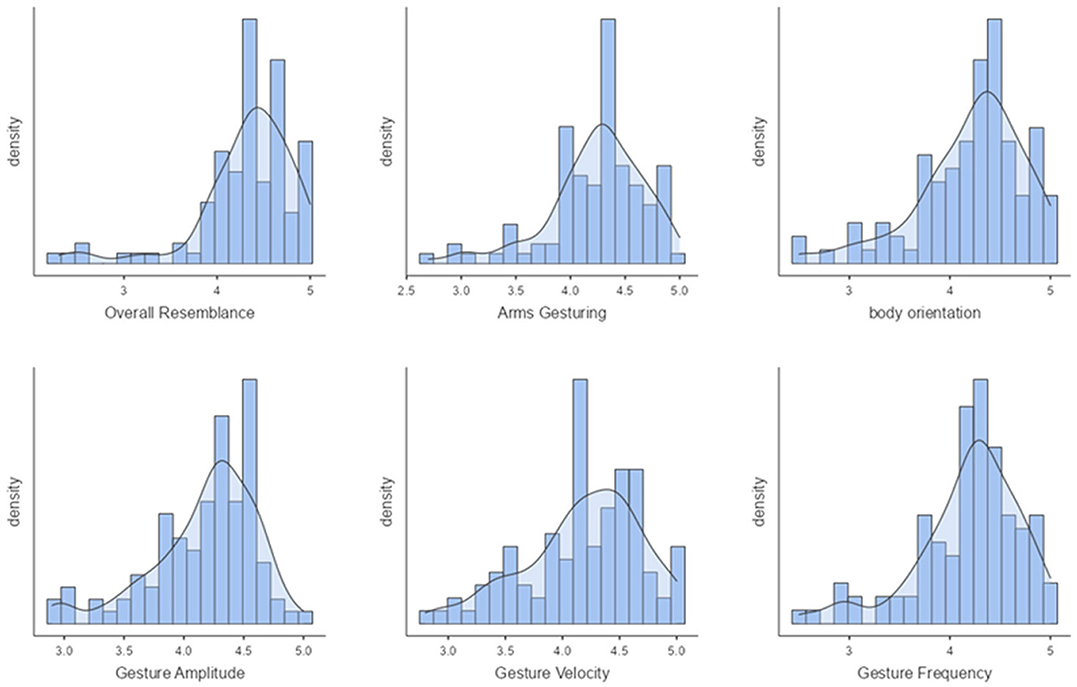
Figure 9. Density plots of overall resemblance, arms gesturing, body orientation, gesture amplitude, gesture frequency, and gesture velocity for seen speakers condition.
We additionally performed post-hoc paired samples t-tests between all the factors and found significant results between overall resemblance and all the other factors (p ≤ 0.008).
Study 2—Unseen Speakers.
Our second perceptive study (Study 2) aims to evaluate the style transfer of speakers unseen during training. Figure 10 illustrates the mean scores obtained on the six factors for the condition "unseen speakers." On a 5-point Likert scale, the overall resemblance factor obtained a score of 3.45, which means that there is an overall resemblance between ZS-MSTM's 2D animations and the unseen target style. The resemblance is also reflected by the mean scores of arms gesturing, body orientation, gesture amplitude, gesture frequency, as well as gesture velocity, which is between 3.28 and 3.41. We observed that for all factors, most of the participants gave a score between 3 and 4, as depicted in Figure 11.
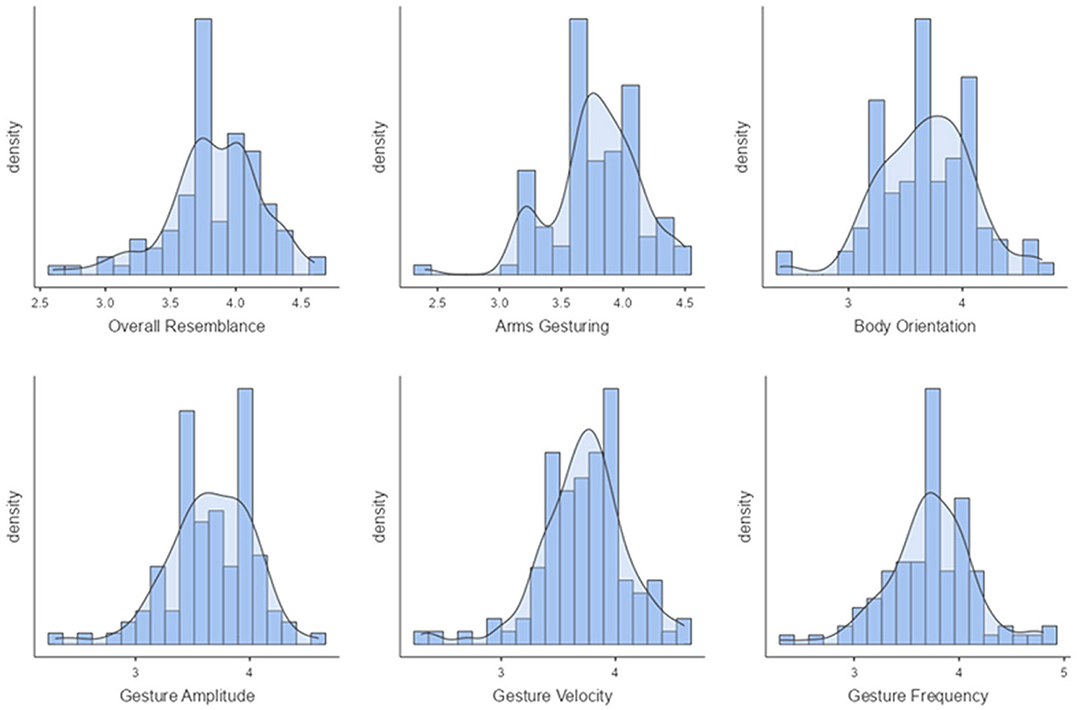
Figure 11. Body orientation, gesture amplitude, gesture frequency, and gesture velocity for unseen speakers condition.
We additionally performed post-hoc paired samples t-tests between all the factors and found significant results between overall resemblance and all the other factors (p ≤ 0.014).
Study 3—Comparing with Mix-StAGE. The third perceptive study aims to compare the performance of our model with respect to the State of the Art, Mix-StAGE. Figure 12 illustrates the mean scores obtained for the two conditions Mix-StAGE and ZS-MSTM, w.r.t the six factors.
As shown in Figure 12, for all the factors, our model obtained higher mean scores than Mix-StAGE. Our model performs better than Mix-StAGE in terms of the overall resemblance of the generated gestures w.r.t the animations produced with the target style (mean score ZS-MSTM (4.2) ≥ mean score Mix-StAGE (3.6)). More specifically, the resemblance between the synthesized 2D gestures of ZS-MSTM and the target style is greater than the one between Mix-StAGE and the target style. This result is also reflected in the resemblance of the arms gesturing, body orientation, gesture amplitude, gesture frequency, and gesture velocity of our model's produced gestures w.r.t the target style. More specifically, our model obtained a mean score between 4 and 4.2 for all the factors, while Mix-StAGE obtained a mean score between 3.8 and 3.6 for all the factors. We additionally conducted post-hoc paired t-tests between the factors in condition Mix-StAGE and those in ZS-MSTM. We found significant results between all the factors in the condition Mix-StAGE and those in ZS-MSTM (p < 0.001 for all). These results show that the mean scores for all the factors in condition ZS-MSTM are significantly greater than those Mix-StAGE. Thus, we can conclude that our model ZS-MSTM can successfully render animations with the style of another speaker, going beyond the state of the art Mix-StAGE.
5. Discussion and conclusion
We have presented ZS-MSTM, the first approach for zero-shot multimodal style transfer for 2D pose synthesis that allows the transfer of style from any speakers seen or unseen during the training phase. To the best of our knowledge, our approach ZS-MSTM is the first to synthesize gestures from a source speaker, which are semantically-aware, speech driven, and conditioned on a multimodal representation of the style of target speakers, in a zero-shot configuration i.e., without requiring any further training or fine-tuning. ZS-MSTM can learn the style latent space of speakers, given their multimodal data, and independently from their identity. It can synthesize body gestures of a source speaker, given the source speaker's mel spectrogram and text semantics, with the style of another target speaker given the target speaker's multimodal behavior style that is encoded through the mel spectrogram, text semantics, and pose modalities. Moreover, our approach is zero-shot, thus is capable of transferring the style of unseen speakers. It is not limited to PATS speakers and can produce gesture in the style of any newly coming speaker without further training or fine-tuning, rendering our approaches zero-shot. Behavioral style is modeled based on multimodal speakers' data and is independent from the speaker's identity ("ID"), which allows our model to generalize style to new unseen speakers. We validated our approach by conducting objective and subjective evaluations. The results of these studies showed that ZS-MSTM generates stylized animations that are close to the target style for target speakers that are seen and unseen by our model. The results of our ablation studies (see Table 4) suggest that all three modalities (text, audio, and pose) are important for the performance of our ZS-MSTM model in style transfer tasks. When any one of these modalities is removed from the style encoder, the L1 distance between the model's predictions and the ground truth increases, indicating lower performance. This shows the importance of incorporating multiple modalities for better style transfer in our model. Moreover, we compared the performance of ZS-MSTM w.r.t the state of the art Mix-StAGE and results showed that ZS-MSTM performs better in terms of overall resemblance of the generated gestures w.r.t the animations produced with the target style. ZS-MSTM can generalize style to new speakers without any fine-tuning or additional training unlike Mix-StAGE. Its independence from the speaker's identity "ID" allows the generalization without being constrained and limited to the speakers used for training the model. DiffGAN was later on proposed by Ahuja et al. (2022) as an extension to Mix-StAGE and an approach that performs few-shot style transfer strategy based on neural domain adaptation accounting for cross-modal grounding shift between the source speaker and target style. However, this adaptation still requires 2 min of the style to be transferred which is not required by our model. Our comparison with the baseline DiffGAN model shows that our ZS-MSTM model outperforms it in terms of both L1 distance and PCK metrics. This shows that our model is better at generating accurate human poses, especially when transferring styles that it has not seen during training. Overall, our results suggest that our ZS-MSTM model is a promising approach for style transfer tasks in human pose estimation as it can leverage multiple modalities to generate poses that are accurate.
Our approach allows the transfer of style from any speakers seen or unseen during the training phase. Behavior style was never viewed as being multimodal; previous works limit behavior style to arm gestures only. However, both text and speech convey style information, and the embedding vector of style must consider the three modalities. Our assumption was confirmed by our post-hoc t-SNE analysis of the distributions of the style vectors at the output of each modality. We found that the motion style depends mainly on the body pose modality, followed by the speech modality, then the text semantics modality. We conducted an objective evaluation and three perceptive studies. The results of these studies show that our model produces stylized animations that are close to the target speakers style even for unseen speakers.
While we have made some strides, there are still some limitations. The main limitation of ZS-MSTM is that it was not evaluated on an ECAs. The main reason is that it was trained on the PATS Corpus, which include 2D poses. The graphical representation of the data as 2D stick figure is not always readable even when being projected on the video of a human speaker. The main reason behind this problem is that the animation is missing information on the body pose in the Z direction (the depth axis). An interesting direction for future work is to extend our model to capture the different gesture shapes and motion. Gesture shapes convey different meanings. For example, a pointing index can indicate a direction. Hand shapes and arm movement can describe an object, an action, etc. Several attempts have looked at modeling metaphoric gestures (Ravenet et al., 2018) or iconic gestures (Bergmann and Kopp, 2009). Most generative models of gestures do not compute the gesture shapes and motions for those specific gesture types. Extending our model to capture gesture shapes and motion would require extending the Corpora PATS to include specific annotations related to gestures shapes and to identify better representations (such as image schemas (Grady, 2005) for metaphoric gestures).
Data availability statement
Publicly available datasets were analyzed in this study. This data can be found here: https://chahuja.com/pats/.
Ethics statement
Ethical approval was not required for the study involving human participants in accordance with the local legislation and institutional requirements. Written informed consent to participate in this study was not required from the participants in accordance with the national legislation and the institutional requirements.
Author contributions
MF is the main contributor of this work and the writing of the paper. CP and NO supervised the work and the writing of the paper. All authors contributed to the article and approved the submitted version.
Funding
This work was performed within the Labex SMART (ANR-11-LABX-65) supported by French state funds managed by the ANR within the Investissements d'Avenir programme under reference ANR-11-IDEX-0004-02. This work was also partially supported by IA ANR-DFG-JST Panorama.
Conflict of interest
The authors declare that the research was conducted in the absence of any commercial or financial relationships that could be construed as a potential conflict of interest.
Publisher's note
All claims expressed in this article are solely those of the authors and do not necessarily represent those of their affiliated organizations, or those of the publisher, the editors and the reviewers. Any product that may be evaluated in this article, or claim that may be made by its manufacturer, is not guaranteed or endorsed by the publisher.
Supplementary material
The Supplementary Material for this article can be found online at: https://www.frontiersin.org/articles/10.3389/frai.2023.1142997/full#supplementary-material
References
Ahuja, C., Lee, D. W., and Morency, L.-P. (2022). “Low-resource adaptation for personalized co-speech gesture generation,” in Proceedings of the IEEE/CVF Conference on Computer Vision and Pattern Recognition (CVPR). doi: 10.1109/CVPR52688.2022.01991
Ahuja, C., Lee, D. W., Nakano, Y. I., and Morency, L.-P. (2020). “Style transfer for co-speech gesture animation: A multi-speaker conditional-mixture approach,” in European Conference on Computer Vision (Springer) 248–265. doi: 10.1007/978-3-030-58523-5_15
Ahuja, C., Ma, S., Morency, L.-P., and Sheikh, Y. (2019). To react or not to react: End-to-end visual pose forecasting for personalized avatar during dyadic conversations,” in 2019 International Conference on Multimodal Interaction, 74–84. doi: 10.1145/3340555.3353725
Alexanderson, S., Henter, G. E., Kucherenko, T., and Beskow, J. (2020). “Style-controllable speech-driven gesture synthesis using normalising flows,” in Computer Graphics Forum (Wiley Online Library) 39, 487–496. doi: 10.1111/cgf.13946
Bell, A. (1984). Language style as audience design. Langu. Soc. 13, 145–204. doi: 10.1017/S004740450001037X
Bergmann, K., and Kopp, S. (2009). “Gnetic-using bayesian decision networks for iconic gesture generation,” in International Workshop on Intelligent Virtual Agents (Springer) 76–89. doi: 10.1007/978-3-642-04380-2_12
Campbell-Kibler, K., Eckert, P., Mendoza-Denton, N., and Moore, E. (2006). “The elements of style,” in Poster presented at New Ways of Analyzing Variation, 35.
Cassell, J. (2000). “Nudge nudge wink wink: Elements of face-to-face conversation for embodied conversational agents,” in Embodied Conversational Characters, eds. J. Cassell, S. P., Sullivan, and E., Churchill (Cambridge, MA: MIT press). doi: 10.7551/mitpress/2697.001.0001
Chiu, C.-C., and Marsella, S. (2014). “Gesture generation with low-dimensional embeddings,” in Proceedings of the 2014 International Conference on Autonomous Agents and Multi-Agent Systems, 781–788.
Cudeiro, D., Bolkart, T., Laidlaw, C., Ranjan, A., and Black, M. J. (2019). “Capture, learning, and synthesis of 3d speaking styles,” in Proceedings of the IEEE/CVF Conference on Computer Vision and Pattern Recognition, 10101–10111. doi: 10.1109/CVPR.2019.01034
Fares, M. (2020). “Towards multimodal human-like characteristics and expressive visual prosody in virtual agents,” in Proceedings of the 2020 International Conference on Multimodal Interaction, 743–747. doi: 10.1145/3382507.3421155
Fares, M., Pelachaud, C., and Obin, N. (2021a). “Multimodal-based upper facial gestures synthesis for engaging virtual agents,” in WACAI 2021.
Fares, M., Pelachaud, C., and Obin, N. (2021b). “Multimodal generation of upper-facial and head gestures with a transformer network using speech and text. arXiv preprint arXiv:2110.04527. doi: 10.48550/arXiv.2110.04527
Ferstl, Y., Neff, M., and McDonnell, R. (2019). “Multi-objective adversarial gesture generation,” in Motion, Interaction and Games, 1–10. doi: 10.1145/3359566.3360053
Ginosar, S., Bar, A., Kohavi, G., Chan, C., Owens, A., and Malik, J. (2019). “Learning individual styles of conversational gesture,” in Proceedings of the IEEE/CVF Conference on Computer Vision and Pattern Recognition (CVPR). doi: 10.1109/CVPR.2019.00361
Ginosar, S., Bar, A., Kohavi, G., Chan, C., Owens, A., and Malik, J. (2019). “Learning individual styles of conversational gesture,” in Proceedings of the IEEE Conference on Computer Vision and Pattern Recognition, 3497–3506. doi: 10.1109/CVPR.2019.00361
Gong, Y., Chung, Y.-A., and Glass, J. (2021). Ast: Audio spectrogram transformer. arXiv preprint arXiv:2104.01778. doi: 10.21437/Interspeech.2021-698
Grady, J. E. (2005). Image schemas and perception: Refining a definition. From Percept Meaning 29, 35. doi: 10.1515/9783110197532.1.35
Hasegawa, D., Kaneko, N., Shirakawa, S., Sakuta, H., and Sumi, K. (2018). “Evaluation of speech-to-gesture generation using bi-directional lstm network,” in Proceedings of the 18th International Conference on Intelligent Virtual Agents 79–86. doi: 10.1145/3267851.3267878
Jia, Y., Zhang, Y., Weiss, R., Wang, Q., Shen, J., Ren, F., et al. (2018). “Transfer learning from speaker verification to multispeaker text-to-speech synthesis,” in Advances in Neural Information Processing Systems 31.
Jonell, P., Kucherenko, T., Henter, G. E., and Beskow, J. (2020). “Let's face it: Probabilistic multi-modal interlocutor-aware generation of facial gestures in dyadic settings,” in Proceedings of the 20th ACM International Conference on Intelligent Virtual Agents 1–8. doi: 10.1145/3383652.3423911
Karras, T., Aila, T., Laine, S., Herva, A., and Lehtinen, J. (2017). Audio-driven facial animation by joint end-to-end learning of pose and emotion. ACM Trans. Graph 36, 1–12. doi: 10.1145/3072959.3073658
Kucherenko, T., Hasegawa, D., Henter, G. E., Kaneko, N., and Kjellström, H. (2019). “Analyzing input and output representations for speech-driven gesture generation,” in Proceedings of the 19th ACM International Conference on Intelligent Virtual Agents 97–104. doi: 10.1145/3308532.3329472
Kucherenko, T., Jonell, P., van Waveren, S., Henter, G. E., Alexanderson, S., Leite, I., et al. (2020). “Gesticulator: A framework for semantically-aware speech-driven gesture generation,” in Proceedings of the ACM International Conference on Multimodal Interaction. doi: 10.1145/3382507.3418815
Lample, G., Zeghidour, N., Usunier, N., Bordes, A., Denoyer, L., and Ranzato, M. (2017). “Fader networks: Manipulating images by sliding attributes,” in Advances in Neural Information Processing Systems 30.
Levine, S., Theobalt, C., and Koltun, V. (2009). “Real-time prosody-driven synthesis of body language,” in ACM SIGGRAPH Asia 1–10. doi: 10.1145/1618452.1618518
Lugrin, B. (2021). Introduction to socially interactive agents,” in The Handbook on Socially Interactive Agents: 20 years of Research on Embodied Conversational Agents, Intelligent Virtual Agents, and Social Robotics Volume 1: Methods, Behavior, Cognition, 1–20. doi: 10.1145/3477322.3477324
Marsella, S., Shapiro, A., Feng, A., Xu, Y., Lhommet, M., and Scherer, S. (2013). “Towards higher quality character performance in previz,” in Proceedings of the Symposium on Digital Production, 31–35. doi: 10.1145/2491832.2491835
McNeill, D., Bertenthal, B., Cole, J., and Gallagher, S. (2005). Gesture-first, but no gestures? Behav. Brain Sci. 28, 138–139. doi: 10.1017/S0140525X05360031
Mendoza-Denton, N. (1999). Style. J. Linguist. Anthropol. 9, 238–240. doi: 10.1525/jlin.1999.9.1-2.238
Moon, S., Kim, S., and Choi, Y.-H. (2022). Mist-tacotron: End-to-end emotional speech synthesis using mel-spectrogram image style transfer. IEEE Access 10, 25455–25463. doi: 10.1109/ACCESS.2022.3156093
Neff, M., Kipp, M., Albrecht, I., and Seidel, H.-P. (2008). Gesture modeling and animation based on a probabilistic re-creation of speaker style. ACM Trans. Graph. 27, 1–24. doi: 10.1145/1330511.1330516
Norris, S. (2004). Analyzing Multimodal Interaction: A Methodological Framework. London: Routledge. doi: 10.4324/9780203379493
Obermeier, C., Kelly, S. D., and Gunter, T. C. (2015). A speaker's gesture style can affect language comprehension: Erp evidence from gesture-speech integration. Soc. Cogn. Affect. Neurosci. 10, 1236–1243. doi: 10.1093/scan/nsv011
Pelachaud, C. (2009). Studies on gesture expressivity for a virtual agent. Speech Commun. 51, 630–639. doi: 10.1016/j.specom.2008.04.009
Ravenet, B., Pelachaud, C., Clavel, C., and Marsella, S. (2018). Automating the production of communicative gestures in embodied characters. Front. Psychol. 9, 1144. doi: 10.3389/fpsyg.2018.01144
Sadoughi, N., and Busso, C. (2018). “Novel realizations of speech-driven head movements with generative adversarial networks,” in 2018 IEEE International Conference on Acoustics, Speech and Signal Processing (ICASSP) (IEEE) 6169–6173. doi: 10.1109/ICASSP.2018.8461967
Sargin, M. E., Yemez, Y., Erzin, E., and Tekalp, A. M. (2008). Analysis of head gesture and prosody patterns for prosody-driven head-gesture animation. IEEE Trans. Patt. Analy. Mach. Intell. 30, 1330–1345. doi: 10.1109/TPAMI.2007.70797
Shlizerman, E., Dery, L., Schoen, H., and Kemelmacher-Shlizerman, I. (2018). “Audio to body dynamics,” in Proceedings of the IEEE Conference on Computer Vision and Pattern Recognition, 7574–7583. doi: 10.1109/CVPR.2018.00790
Vaswani, A., Shazeer, N., Parmar, N., Uszkoreit, J., Jones, L., Gomez, A. N., et al. (2017). Attention is all you need. arXiv preprint arXiv:1706.03762. doi: 10.48550/arXiv.1706.03762
Wagner, P., Malisz, Z., and Kopp, S. (2014). Gesture and speech in interaction: An overview. Speech Commun. 57, 209–232. doi: 10.1016/j.specom.2013.09.008
Keywords: multimodal gesture synthesis, zero-shot style transfer, embodied conversational agents, transformers, multimodal behavior style
Citation: Fares M, Pelachaud C and Obin N (2023) Zero-shot style transfer for gesture animation driven by text and speech using adversarial disentanglement of multimodal style encoding. Front. Artif. Intell. 6:1142997. doi: 10.3389/frai.2023.1142997
Received: 12 January 2023; Accepted: 18 May 2023;
Published: 12 June 2023.
Edited by:
Sreyasee Das Bhattacharjee, University at Buffalo, United StatesReviewed by:
Monika Akbar, The University of Texas at El Paso, United StatesFeng Chen, Dallas County, United States
Copyright © 2023 Fares, Pelachaud and Obin. This is an open-access article distributed under the terms of the Creative Commons Attribution License (CC BY). The use, distribution or reproduction in other forums is permitted, provided the original author(s) and the copyright owner(s) are credited and that the original publication in this journal is cited, in accordance with accepted academic practice. No use, distribution or reproduction is permitted which does not comply with these terms.
*Correspondence: Mireille Fares, ZmFyZXNAaXNpci51cG1jLmZy; ZmFyZXNAaXJjYW0uZnI=
 Mireille Fares
Mireille Fares Catherine Pelachaud
Catherine Pelachaud Nicolas Obin
Nicolas Obin